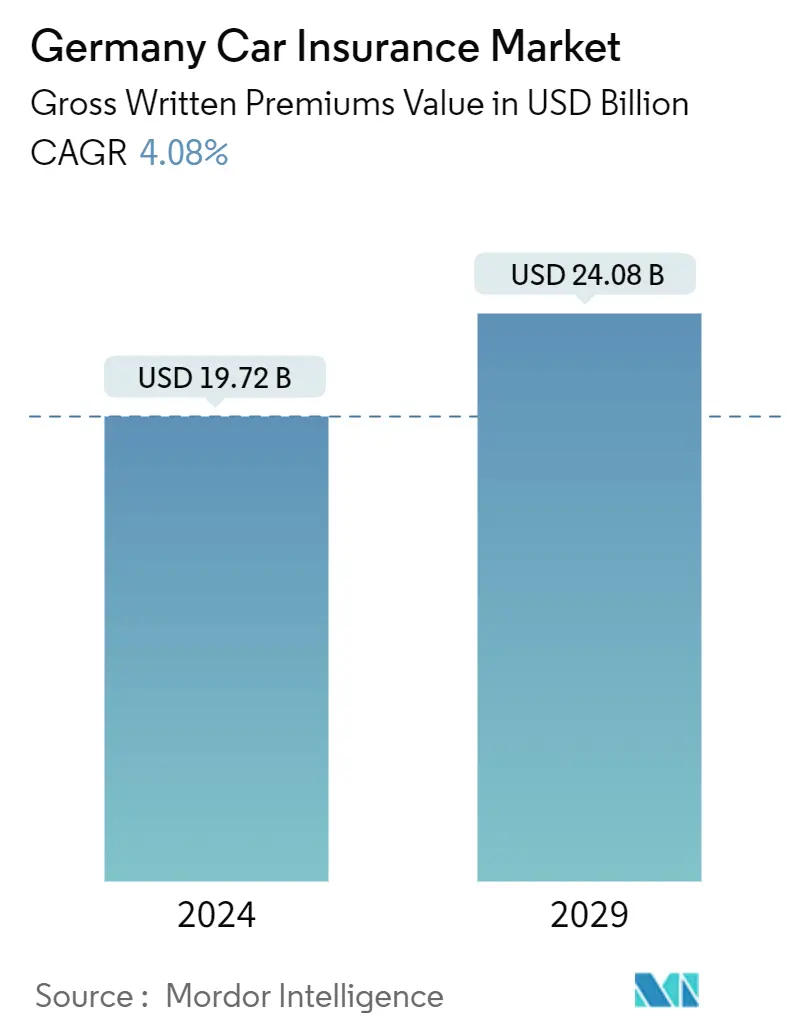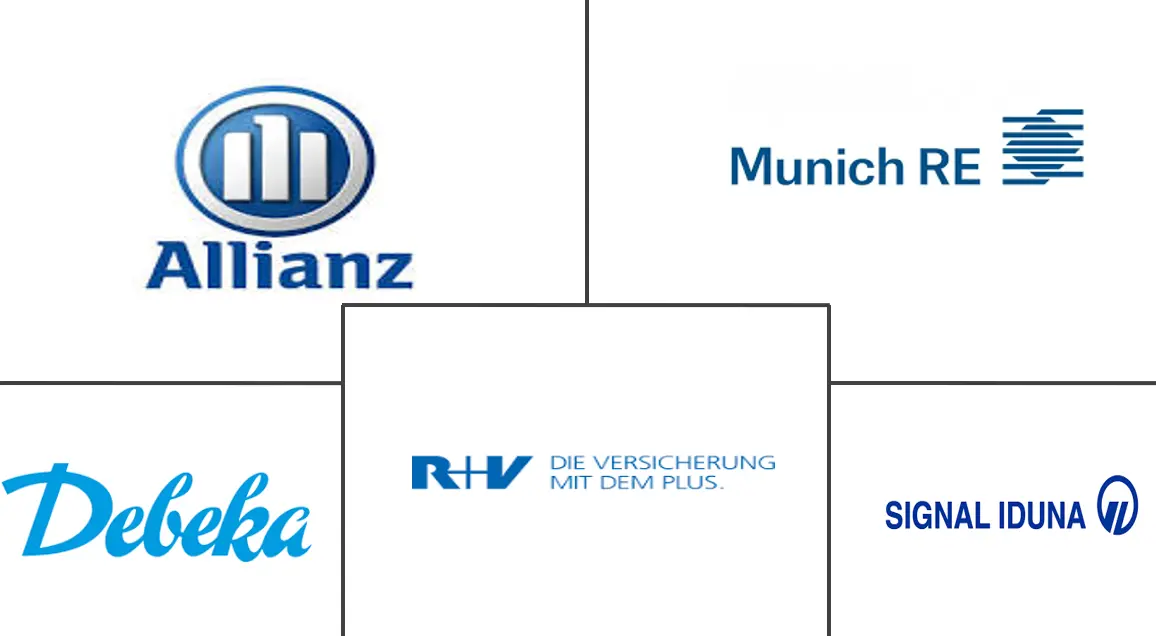Market Size of Germany Car Insurance Industry

| Study Period | 2020-2029 |
| Base Year For Estimation | 2023 |
| Market Size (2024) | USD 19.72 Billion |
| Market Size (2029) | USD 24.08 Billion |
| CAGR (2024 - 2029) | 4.08 % |
| Market Concentration | Medium |
Major Players
*Disclaimer: Major Players sorted in no particular order |
Germany Car Insurance Market Analysis
The Germany Car Insurance Market size in terms of gross written premiums value is expected to grow from USD 19.72 billion in 2024 to USD 24.08 billion by 2029, at a CAGR of 4.08% during the forecast period (2024-2029).
Germany has a strong car industry all the people who live in Germany drive cars regularly. Car insurance is important for all drivers in Germany because it serves as a safeguard for drivers. According to the law in the country, all cars must have at least third-party insurance to cover damages. At the end of every year, there are millions of people in Germany who buy car insurance because there is an increase in awareness among consumers regarding the benefits of car insurance. The German government issued a policy that car insurance should be mandatory to register the car if a person is a long-term resident of Germany,
Post COVID-19, there was an increase in the purchase of car insurance in Germany because of rising prices in car repair in shops and also the impact of driving behavior after the pandemic.
German car insurers boost market growth through product innovation, introducing new insurance offerings and services like roadside assistance. German car insurers introduced mobile-based telematics for car insurance programs focused on services and have no impact in insurance premiums.
Germany Car Insurance Industry Segmentation
Car insurance is a type of insurance that provides cover for loss or damage to the car. It helps to mitigate monetary harms due to accidents causing damage to the cars. Germany's car insurance market is segmented by coverage, application, and distribution channel. By coverage, the market is segmented into third-party liability coverage and collision/comprehensive/other optional coverage. By application, the market is segmented into personal vehicles and commercial vehicles. By distribution channel, the market is segmented into individual agents, brokers, banks, online, and other distribution channels. Other distribution channels include financial institutions other than banks, phone marketing, and mail marketing. The report also covers the market sizes and forecasts for the German car insurance market in value (USD) for all the above segments.
| By Coverage | |
| Third-Party Liability Coverage | |
| Collision/Comprehensive/Other Optional Coverage |
| By Application | |
| Personal Vehicles | |
| Commercial Vehicles |
| By Distribution Channel | |
| Direct Sales | |
| Individual Agents | |
| Brokers | |
| Banks | |
| Online | |
| Other Distribution Channels |
Germany Car Insurance Market Size Summary
The German car insurance market is poised for significant growth, driven by the country's robust automotive industry and the legal requirement for mandatory insurance coverage. As all vehicles in Germany must have at least third-party insurance, the market benefits from a high level of consumer awareness regarding the importance of car insurance. The post-pandemic period has seen an uptick in insurance purchases, attributed to rising car repair costs and changing driving behaviors. The market is characterized by innovation, with insurers introducing new products and services, such as mobile-based telematics and roadside assistance, to enhance customer experience. Digitalization plays a crucial role in market expansion, with companies leveraging advanced technologies like machine learning, IoT, and data analytics to offer more accessible and efficient insurance solutions.
The German car insurance industry is consolidated, with major players like Münchener Rückversicherungs-Gesellschaft, Allianz, and SIGNAL IDUNA leading the market. The increase in traffic accidents and car damage has been a significant driver of market growth, emphasizing the need for comprehensive insurance coverage. Partnerships and collaborations, such as those between Wrisk and Mobilize Financial Services, and Signal Iduna and Google Cloud, highlight the industry's focus on developing flexible, customer-oriented insurance products. These strategic initiatives aim to enhance service offerings and streamline operations, further propelling the market's expansion during the forecast period.
Germany Car Insurance Market Size - Table of Contents
-
1. MARKET DYNAMICS AND INSIGHTS
-
1.1 Market Overview
-
1.2 Market Drivers
-
1.2.1 Rising Sales of Cars in Germany Drives The Market
-
1.2.2 Increase in Road Traffic Accidents Drives The Market
-
-
1.3 Market Restraints
-
1.3.1 Increase in Cost of Claims Made
-
1.3.2 Increase in False Claims and Scams
-
-
1.4 Market Opportunities
-
1.4.1 Online Car Insurance Products Expanding the Car Insurance Sales
-
1.4.2 Demand for Customized Insurance Products by the Buyers
-
-
1.5 Industry Value Chain Analysis
-
1.6 Industry Attractiveness - Porter's Five Forces Analysis
-
1.6.1 Threat of New Entrants
-
1.6.2 Bargaining Power of Buyers
-
1.6.3 Bargaining Power of Suppliers
-
1.6.4 Threat of Substitutes
-
1.6.5 Intensity of Competitive Rivalry
-
-
1.7 Insights on technology innovation in the Market.
-
1.8 Impact of COVID-19 on the Market
-
-
2. MARKET SEGMENTATION
-
2.1 By Coverage
-
2.1.1 Third-Party Liability Coverage
-
2.1.2 Collision/Comprehensive/Other Optional Coverage
-
-
2.2 By Application
-
2.2.1 Personal Vehicles
-
2.2.2 Commercial Vehicles
-
-
2.3 By Distribution Channel
-
2.3.1 Direct Sales
-
2.3.2 Individual Agents
-
2.3.3 Brokers
-
2.3.4 Banks
-
2.3.5 Online
-
2.3.6 Other Distribution Channels
-
-
Germany Car Insurance Market Size FAQs
How big is the Germany Car Insurance Market?
The Germany Car Insurance Market size is expected to reach USD 19.72 billion in 2024 and grow at a CAGR of 4.08% to reach USD 24.08 billion by 2029.
What is the current Germany Car Insurance Market size?
In 2024, the Germany Car Insurance Market size is expected to reach USD 19.72 billion.

